|
In part one of
solving the Musky Mystery, I mentioned a few of the most effective
shallow water, casting techniques to catch Musky. In part two,
weíll look at a few of the trolling presentations that will help
you put even more Muskies in the boat.
In many ways trolling and casting are different, but they do have
one key thing in common so letís use this quote from part one to
recap Musky fishing rule number one: "The biggest secret (if there
is one) is to spend time on "good Musky Water". Youíll learn more
and develop confidence a lot faster if you spend your time fishing
lakes with good populations of fish. Avoid the old trap of heading
out to every lake that is rumored to have a couple of big ones,
you can do better than that. Thanks in large part to the efforts
of Musky devotees and organizations like Muskies, Inc. with
cooperation from the DNR, there are more Muskies to catch today
than ever before. Take advantage of the wealth of information that
these folks have put together and in short order youíll have a
good list of quality lakes to get started on."
Trolling could arguably rank high as one of the most effective
ways to catch a Musky. But for me, there is one element of
trolling that falls into the category of "UN-sportsmanlike
conduct" and thatís trolling in shallow water. Depending on your
point of view, trolling in general may or may not be considered
"sportsmanlike". But, thereís no doubt that trolling through prime
shallow-water weed cover is certainly not a great way to
help make your fishery better. I fish on some lakes that have been
on the receiving end of intense trolling pressure and at times,
Iíve seen it take a toll on favored, shallow water weed growth.
Itís important that we bear in mind our impact on this shallow
cover and do what we can to minimize our impact. Protecting
shallow water habitat is not only good for game fish, but provides
cover for smaller forage species, other wildlife and helps improve
water quality. So after I said all that, lets focus here primarily
on simple but effective techniques for trolling in deeper open
water. By the way, "open water" could also easily include "flat"
sand or gravel areas adjacent to weed cover.
Long ago we assumed that the "best" place to catch Muskies was
where we could occasionally see them. Areas like shallow weeds,
rocks and other shoreline-related cover. These areas do often hold
Muskies. But while they might be feeding in these areas during
spring, early summer and late fall when forage is available in
shallow water, weíve learned that often, these shallow areas are
used by Musky primarily for resting. We know now that at most
times of the year, the abundance of suitable food like Ciscoís,
Whitefish, Suckers and other open water forage species attract
actively feeding Muskies out into deeper, open water. These large
fish locate schools of larger forage fish and really "strap on the
feed bag" returning to shallow water cover when they need rest.
Getting started is a lot simpler than you might think, the two
basic rules to keep in mind are; 1) You have to stay near fish and
2) You have to get your bait near a fish to catch one.
The idea of trolling in open water conjures up images of large
boats and thousands of dollars worth of special gear like
downriggers, planer boards and everything that goes with that. If
youíve got a larger boat and lots of gear, you obviously have more
flexibility and can take advantage of more opportunities. Thereís
no reason that you shouldnít acquire all of the goodies if you
want to, but if you canít shell out big bucks right now to get
started, you can still get in the game. In fact, there are lots of
small lakes where open water trolling works like a charm for folks
with small boats and limited amounts of tackle. By picking the
right lake, even folks equipped with simple gear and a small boat
can cover plenty of ground during an average fishing day. That
said, youíre going to need at least a few key pieces of gear to
make it worth your time.
Hereís a short, but important list of items I consider a must for
open water trolling. A graph that allows you to see both suspended
fish and baitfish, a heavy action trolling rod in the seven to
eight-foot range, a reliable level wind reel spooled with good
line, a small assortment of deep-diving crankbaits and an
assortment of bell sinkers, swivels and strong leaders. Also,
unless you have an intimate knowledge of the lakes structure,
youíll need at least a good plastic or paper map.
A few extras that would be nice could include a GPS and mapping
chip (for the GPS). A line counting reel and a couple of good rod
holders. An extra spare rod would be nice too, but if itís not in
the budget, donít sweat it.
Locating a Musky in open water is easiest by concentrating on
areas where theyíll be relating to schools of forage fish. You
donít necessarily need to see a Musky on your graph (although
eventually you will), just keep searching for "baitfish" that are
large enough to attract feeding Muskies. Weíre not looking for the
clouds of smaller baitfish that weíd seek if we were looking for
Walleye, Crappie or Bass. Remember that weíre looking for forage
thatís large enough show up on your graph as "separate fish". To a
Musky, almost any fish in the lake is food. A four-pound Sucker
is a baitfish, so are 2 pound Whitefish and half pound
Ciscoís. Watch your graph and focus on the areas where fish are
abundant. To put the odds in your favor, the more fish you locate,
the better. Itís true that you may not know for sure what kind of
fish that youíre looking at on the screen, but to a Musky it wonít
matter.
Choosing a small assortment of quality baits is best accomplished
after studying your lake a bit. Since weíll plan to use these
baits primarily for open water trolling, concentrate on the bigger
billed deeper diving versions of baits like the Cisco Kid, Salmo
Whitefish, Bagleyís DB06, Giant Rapalas and other baits of this
type. These are all good choices and all available in colors that
work in lots of Midwest fishing situations. Getting the best color
is a matter of matching that emulate the forage species in the
lake youíre going to fish. Use your imagination and include colors
that cover a variety of situations that could arise on your lake.
For a lake with lots of Suckers or Smallmouth Bass, you might want
to go with larger crankbaits in natural colors like gold, brown or
orange. If your lake has more Cisco or Whitefish, you might go
with thinner baits in the silver, blue and green schemes. Donít
overlook lures that emulate small Northern Pike, Walleye or Perch,
whatever forage is plentiful in your lake is probably also on the
Muskieís menu.
In a lot of areas, there are groups of lakes with similar
structures and forage bases so youíll be able to get double duty
from lots of them. Keep in mind that in the beginning youíre
better off with a handful of good quality baits. As you gain
experience, you can add to the collection intelligently and in the
long run youíll end up with a super selection of great trolling
baits.
Trolling rods for large baits need to be heavy enough at the butt
section to keep your crankbait under control, but have a sensitive
enough tip to let you feel the swimming action of the bait. I use
a G. Loomis MUR946C-TR that can handle lures all the way up to 6
ounces and is just shy of 8 feet long. A minimum of a seven-foot
(or longer) rod will help you keep the bait out away from the boat
and allow you to troll without using planer boards. Trolling
without boards or downriggers is commonly referred to as "flat
lining". Besides helping get the bait out away from the boat, the
longer heavier rod will help take the pressure off of your forearm
if youíre holding it by hand. It wonít take long to figure out
that a wimpy rod isnít going to cut it for trolling larger
crankbaits especially with added weights for going deep. A rod
holder with a secure locking mechanism would really come in handy
too.
Trolling your lure at the proper depth is vital, so itís important
that you try to choose your baits and gear based on getting them
to the depth where the forage (or game fish) is located.
Repeatability is also important so you need to develop confidence
in some system that allows you to get your bait to the same depth
every time. For example, if I see lots of forage at 20 feet, I
could troll my favorite 9-inch Cisco Kid 90 feet behind the boat
without adding any weight. But if Iíve seen most of the action
down at 40 feet, Iíd need to either change to deeper running bait
or add extra weight. One really simple way of getting your bait
deep into the "kill zone" is a drop weight rigged on a three-way
swivel. Tie one side of the three-way swivel to your line; add a
leader to the opposing side and finally rig a drop line with a
loop from the third side of the swivel. By experimenting with bell
sinkers of varying weights you can easily learn to control the
depth of your lure.
To really lock in your ability to fine tune the trolling depth,
youíd ideally go with a line counter type reel to help get your
lure back to the same depth every time. If you donít have one or
donít want to go that route, you can devise other systems for
keeping track of distance too. Count the times the line travels
from one side of the spool to the other; count rod lengths and so
on. No matter how you go about it, the idea is to learn to put the
lure where the fish are. Iíve tried quite a few lines on my Musky
reels but I always wind up going back to Fireline and I think this
is about as versatile as it gets.
Often, the forage will relate to structure like deep-water humps
or sunken islands and deep holes located close to steep drop-off
areas along main lake flats or bars. A great trolling approach is
to follow a path or route that takes you near a number of these
deep-water fishing structures. For example you might troll the
open water along a sharp drop off until you come near a sunken
island.
(Continued) >>
|
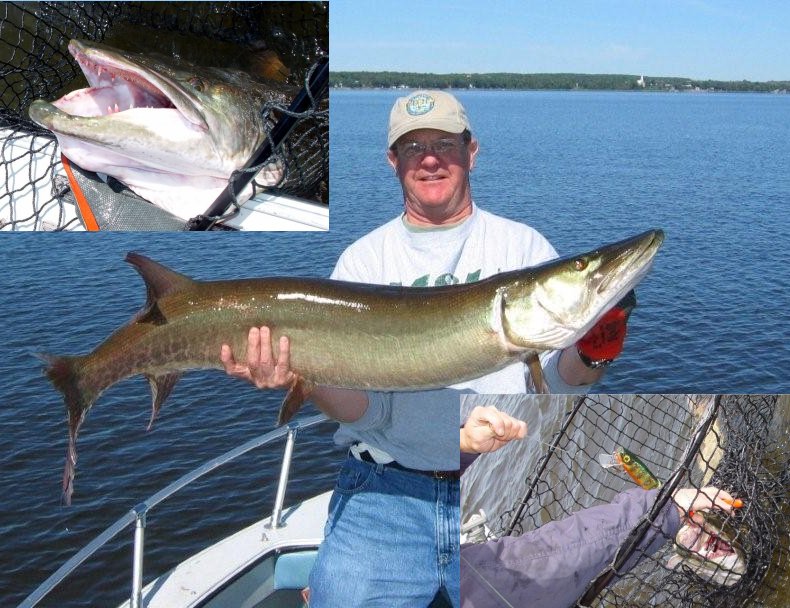
Photo courtesy of Bruce Champion.
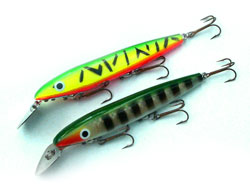
Deep diving, large crankbaits like
these Cisco Kids (above) are just what the doctor ordered for
trolling over open water. You should try to match the colors to
forage species common in your lake. Other baits (below) could
include Salmo's Whitefish, Bagley's DB06
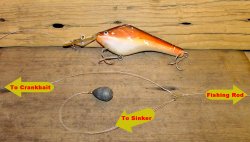
A "poor mans downrigger" consists of a
three way swivel, heavy bell sinker and leader. By varying the
sinker weight, you can custom tune your trolling depth to almost
any situation.
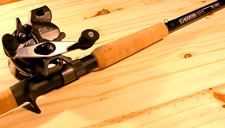
For control, longer rods like the
G. Loomis MUR946C with a matching line counter reel will help put
the bait in the strike zone.
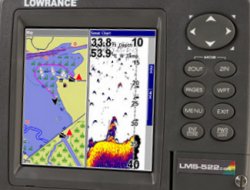
Lots of suspended forage, including
a variety of larger fish is a good indication that you're in the
right neighborhood. Spotting a Musky on the graph is exciting, but
you don't necessarily need to see one to catch it.
(continued) Turn away from the drop off and continue trolling
through open water until you arrive at the sunken island and make
a wide turn, troll around that sunken island and begin moving
toward another structure. Obviously the more structure your lake
has, the more intricate your route can be. On one small lake near
my home, there are only a handful of sunken islands and a couple
of sharper drop of areas. On lakes like that, I can troll "the
route" from one side of the lake to the other and then reverse my
path and go back. You might decide to repeat the same route
several times on small lakes or choose to cover miles of territory
on larger lakes.
Okay, so thereís enough information to give you a taste of
trolling for Muskies. A lot has been left unsaid but thatís where
your imagination kicks in. The fun is in experimenting with
trolling speeds, mixing up presentations and creating open water
scenarios to try. Add your own personal touch and youíre on your
way to mastering the sport, one trip at a time. |
